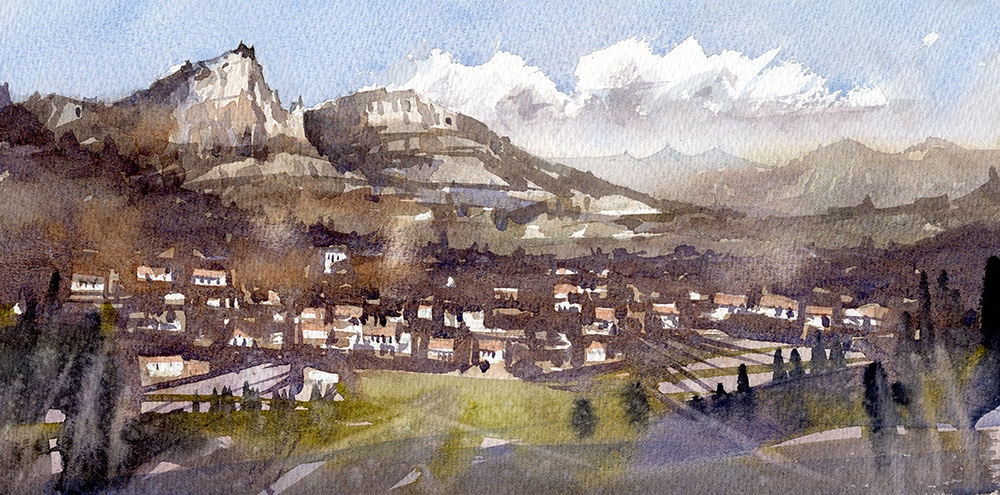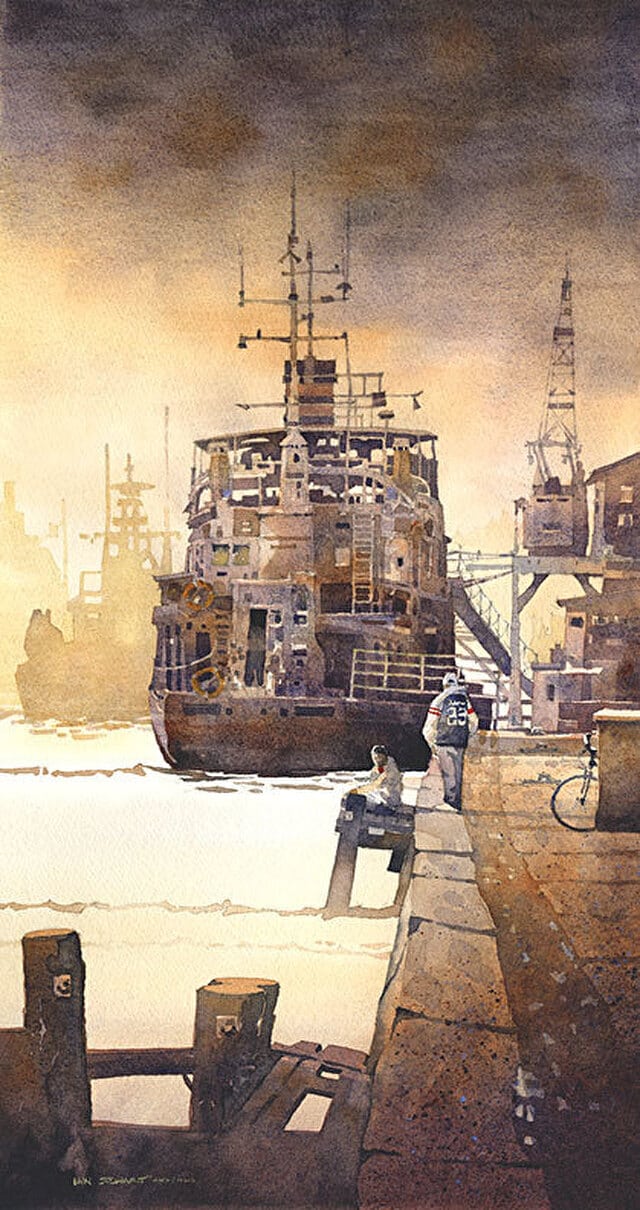Share:
Travel is a wonderful thing. It teaches, it expands us, new people come in to our lives, new sights, new places. I haven’t seen home in 41 days. During that time I’ve been fortunate to teach and paint in some of the most beautiful places in the world and for that I am grateful beyond belief. Mostly, I think, it’s seeing how other people in different countries go about their lives, deal with everyday problems, manage work, kids, and the way they choose to view the world. With the right attitude something that could easily be viewed as a hassle can be laughed off and become even more poignant and ultimately a more enjoyable memory. I’ve been surrounded by people who seem to take the same view of these circumstances during this trip. Geneva seems like a year ago, London a few months, Noelle Stewart ages and the same for my son. As I sit here on a porch overlooking a beautiful lake with the sun shining in a very small village in Sweden I can’t help but ruminate on the ups and downs life delivers and the ability within us all to choose how we perceive them.Perception is key- opportunity or adversity.

Playing some familiar music on the digital gramaphone, mingled with the chirping of the birds, the wind in the trees, and the lapping of water on rocks. Would I change this moment? No. I could think of a couple of additions that would make it more pleasant at the moment, but again, perception of my circs makes me pause. 6 years ago- I was a full time archetectural illustrator working days on end in the same pair of pyjamas, juggling deadlines and clients. Today, after a lot of thought and deciding that a life change was in order, I am where I am.
On the road, living out of a suitcase, and a bag of painting gear. I’m so happily tired. I miss my wife, my son, my dogs, and possibly the cat. I miss my comfy chair. I miss the routine of home. Cooking, cleaning, awaiting Noelle to come home from work so I can show her a new painting. A glass of beer and a cuddle. Today I’m grabbing that bag of painting gear and going out to do what I love knowing my family understands this. For that I will am grateful. It allows me to move forward and not just count days off a calendar before the return home. I wish that same comfort for you and in the words of a good friend. My limitless love to you all.

17 July, 2016 Alabama
I was speaking yesterday to my father, Muir, who is an excellent watercolorist and fairly versed traveler having done 6-8 weeks in Italy and France for many years running. I’ve been home for 3 days. He said I sounded tired. When I tried to explain my reasoning behind it he said “don’t say a thing, I know exactly how you feel.” We sat for a moment over the telephone in silence, the realization dawning on me that he does know what I’m feeling and perhaps better than I do. That one burned me out. Plain and simple. As I sit here writing this with my dogs snoring around me and a cup of good coffee I understand this sentiment even clearer. It’s not that I’m physically tired, which I am, it’s that my mind is on full overload and, try as I might, I cannot neglect that feeling or pass it off as something I’ll get over in time. I can hear the whispers beginning….
“Is he complaining about getting to spend 6 weeks in Europe painting and sketching?”
“I’d like that problem.”

No, I am not complaining by any means. My purpose in writing this is to give you some insight in to how I work and the things that drive me to push that in new directions. First of all, even given the location, what I do at times is considered by many to be something akin to a vacation from reality when it is the exact opposite. Heading out in to a city with your plein air kit or sketchbook and backpack is a fantastic lesson in observing and recording your reality. I rarely do additional work to sketches started on site later in the day if I’m run off by the weather. Scotland is pretty good at doing that to you by the way. I’d much rather have the beginnings of a sketch to do studio work from and photographic references than forget at what point the rain became too much and how I had to pack quickly to get myself and my gear out of the weather. These are the lessons that I carry with me. They are how I can remember the day, the idea on which the sketch was built, and what I can take from the bones of the sketch to use in the studio.
I believe you have to love it. Those breakthroughs and the work done on site are rarely easy. It takes discipline and determination to head out solo and keep going when your feet are wet and Scotland is doling out some of it’s famous weather. Living out of a suitcase sounds great but try washing your underwear in a sink for the umpteenth time. It’s also a part of how I approach teaching en plein air. If the weather goes upside-down you can’t shake your fist at the sky in a mock Basil Fawlty impersonation. I gather my students and we move. There is also an unhealthy aspect to expectations when painting in the great wide open. It rarely goes as planned and you have to be aware of this. Most paintings done on site are not masterpieces let alone extremely good. Of course the more you do it the better you get as with any other discipline. I’ve been sketching outside since I was in architecture school. I’ve done some nice work and some pieces that I would rather burn than show in public. That’s the beauty of the sketchbook. You get to choose what you show. A sketchbook is your place of refuge, exploration, and observance. It is yours to share or not. The same goes for the work you do on an easel. Sure, it’s a trophy shot, you standing on a bluff overlooking some beautiful scene with brush in hand and a decidedly serious expression on your face. It’s very alluring but, for the most part, untrue. The reality is your legs are getting sunburned, you keep having to find rocks to weigh down your easel to keep it flying like a kite of of said bluff, the gnats are going for your vitals, and those clouds are getting much closer and more menacing.

The work is key here- so is your attitude. Find the good bits and embrace the bad. This is how you begin to start the very important lessons of self critique. In my workshops I suggest that the students write down where they feel they went off the tracks on a certain painting and then write a plan for fixing it on another try. The act of writing about what you are going to do with a painting, along with some preliminary sketching, begins to merge the right and left brain. You can be critical but once you leave the written page for the painted one those initial ideas stay with you. I ask that they do the same writing again once the painting is completed and see where they strayed from the original idea. A painting has a mind of it’s own and at some point during the process what is on your paper becomes more important than the subject you are viewing. Pay attention to that moment it is all important and fleeting. Finding that sweet spot is hard, but again, the more you paint outside the more you are going to find yourself getting closer to it. Go easy on yourself and allow these things to happen in time. I think the constant barrage of gifted artists showing their accomplishments done on site make the student believe they should be doing the same or at least getting closer than they are. For every one good one I do at least three bad ones. Some of you may disagree but that’s how I feel about it. The thing is I don’t let them get me down. I know I have a shot on the next one and move on. I also am rarely the best judge of my own work especially when I’ve just completed it- or think I have.







